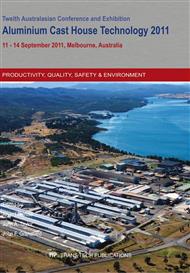p.122
p.133
p.141
p.149
p.161
p.169
p.179
p.187
p.196
Development of a Fused Magnesium Chloride Containing Refining Flux Based on a Ternary System
Abstract:
The costs of salt flux treatment have received a strong industry focus as solid flux addition has replaced the usage of Chlorine for alkali and inclusion reduction. The magnesium chloride component has historically had the higher cost incidence but since 2008 the potassium chloride component because of its role as feedstock of fertilizer production has been subject to large commodity price driven fluctuations and rose 350% in 200 – 2009. As demand for world food production and bio fuels increases as the global economy recovers further price rises can be anticipated. A programme of work and field results are presented on the development of an alternative flux system based on a ternary composition.
Info:
Periodical:
Pages:
161-168
Citation:
Online since:
July 2011
Authors:
Price:
Сopyright:
© 2011 Trans Tech Publications Ltd. All Rights Reserved
Share:
Citation:


